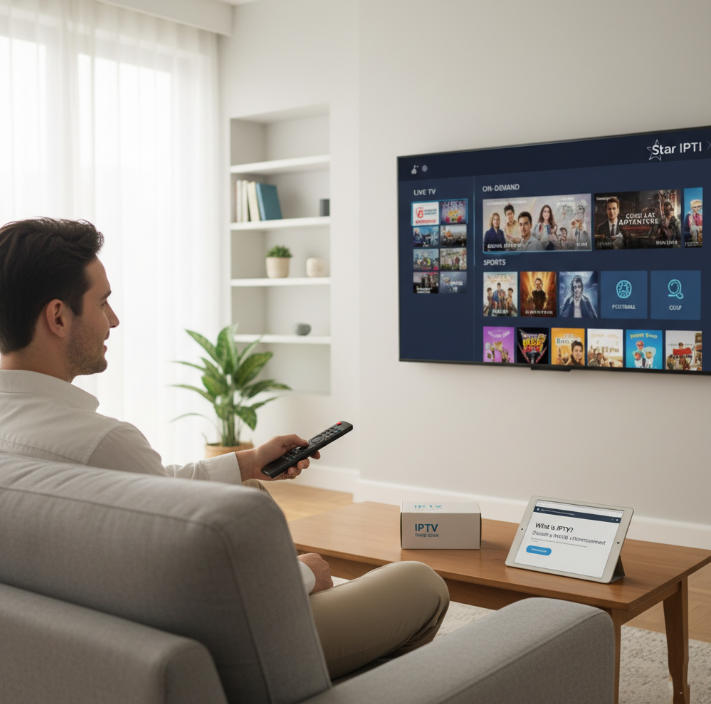Thinking about jumping into the IPTV game? You're not alone. With folks ditching cable left and right and looking for smarter ways to stream, IPTV has become a goldmine for tech-savvy go-getters. It’s like turning your own little media empire into reality—without needing a truckload of gear or a Hollywood budget. To ground the basics, what is IPTV covers how Internet Protocol TV works at a high level, and a broader technical definition from Internet Protocol television (IPTV) provides an industry-standard view.
But let’s be real—this stuff can get tricky. Between murky legal rules, licensing hoops, and the tech setups that feel like decoding rocket science, many hopefuls burn out before they ever go live.
“I’ve seen more startups crash from confusion than competition,” says Jake Monroe, senior IPTV systems engineer at StarStream. “They just don’t know where to begin.”
If that hits close to home, you’re in the right place. This guide breaks it down in plain speak—from what IPTV actually is to the legal must-knows and the step-by-step to get your service off the ground. You can also skim a practical overview of compliant service models here: is IPTV legal in US, which aligns with the common rule that IPTV is legal when rights are licensed, echoing guidance from industry explainers like Is IPTV Legal?.
What is IPTV and How Does It Work?
Internet Protocol TV Explained Through Everyday Use
Internet Protocol TV isn’t just tech jargon — it's how your binge-watching sessions even happen. If you need a quick primer, this plain-language walkthrough of what is IPTV pairs well with the formal definition on IPTV (Wikipedia).
Think of IPTV as digital TV over the internet, replacing traditional broadcasting — essentially live and on-demand delivery over IP networks as outlined in IPTV (Wikipedia).
Your home network becomes a mini content highway, streaming shows straight from the cloud to your screen (see the VOD concept in Video on demand).
No satellite dish or cable required — just bandwidth and a good connection. Typical speed guidance for consumers is similar to streaming benchmarks like Netflix’s: e.g., ~5 Mbps for 1080p and ~15 Mbps for 4K per Netflix-recommended internet speeds.
People casually using Streaming apps on Smart TVs or catching sports on their phones are already using IPTV — they just don't call it that.
IPTV content delivery feels seamless because it delivers exactly what you ask for, when you ask for it. Boom. Press play, and you're in. Adaptive delivery is commonly implemented with HLS, which “dynamically adapts to network conditions” per Apple’s HTTP Live Streaming (HLS).
Types of IPTV Services: Live Streaming, VOD, and Catch-up TV
Not all IPTV Services are created equal. Each type has its own vibe, kinda like your favorite genres.
Live Streaming
Always-on broadcasting, like watching the news or a soccer match in real-time. Think “appointment viewing” — but online.
Video on Demand (VOD)
This is your “watch what you want, when you want” model. Movies, TV shows, even music videos, all tucked neatly into a Content Library. For a primer, see Video on demand.
Catch-up TV
Missed last night’s thriller episode? Catch-up TV lets you rewind life. It stores recently aired content so you can rewatch it before it expires. A general definition is captured in the Cambridge Dictionary entry for catch-up TV.
Each model fits different Subscription styles — Premium for VOD, or Free for Catch-up replays. Your IPTV platform should ideally include a mix for broader appeal. If you’re exploring plan design, see StarIPTV’s IPTV subscription options to benchmark tiers and packaging.
How Smart TVs and Game Consoles Deliver IPTV Content
Your TV isn’t dumb anymore, and your gaming rig is moonlighting as a streaming machine.
Most Smart TVs have built-in Streaming Apps like Netflix or YouTube that support IPTV Content (typical install flows match guides like Lifewire’s walkthrough on downloading apps on Samsung Smart TV).
Game Consoles like PlayStation and Xbox? Yep, they run IPTV apps too.
Users find and install apps via App Stores built into the devices.
All these devices rely on a steady Internet Connection — no signal bars needed here, just fast Wi-Fi or Ethernet. For quality targets, consumer services commonly reference thresholds such as those in Netflix-recommended internet speeds.
The User Interface is designed for chill browsing. Swipe left, scroll down, click play. Done.
To stay competitive, make sure your IPTV business supports these platforms — or you’ll miss half your audience. If you’re building for many devices, StarIPTV’s IPTV setup guide shows typical cross-device activation steps.
From SD to 4K: Understanding Video Quality Standards
Video resolution matters way more than you’d think. It’s not just about pixels — it’s about experience.
SD (Standard Definition) is the old-school, grainy cousin. Think basic channels on an old cable box.
HD (High Definition) brings crisper lines, better clarity — great for fast-moving content like sports or action films.
4K and Ultra HD? That’s premium territory. You can see the sweat on a quarterback’s face or every frame of an animated scene.
But here’s the catch: Higher Image Quality means more bandwidth. If your users have spotty internet, too much 4K = buffering headaches. Practical streaming thresholds that many consumers follow (e.g., 1080p ≈ 5 Mbps; 4K ≈ 15 Mbps) are documented by Netflix-recommended internet speeds.
As an IPTV operator, balance Video Resolution with user internet speeds. Offer multiple quality options, like SD for mobile users and 4K for big-screen fans. On the delivery side, adaptive protocols like HLS help clients shift bitrates automatically based on real-time network conditions.
Do You Need a License to Run an IPTV Business?
Licensing Requirements by Content Type: Movies, Sports, and Kids Content
Thinking of streaming a mix of blockbuster Movies, nail-biting Sports, and sweet Kids Content on your IPTV platform? Hold up — not so fast. Licensing isn’t optional; it’s mission-critical.
IPTV licenses are usually content-type specific — you won’t get a one-size-fits-all pass. A general rule of thumb repeated in many explainers (e.g., Is IPTV Legal?) is that you must obtain proper authorization and distribution rights.
Movies often require separate permissions for trailers, behind-the-scenes footage, and the main film. Public performance and streaming rights typically require licensed permissions (see U.S. Copyright Office’s Licensing Overview and library guidance on Public Performance Rights).
Sports licensing is strict. Many leagues (like the NBA) limit or geo-restrict IPTV broadcast rights; e.g., the NBA’s 11-year U.S. media agreements with Disney, NBCUniversal, and Amazon demonstrate tightly controlled distribution (NBA announces new 11-year media agreements).
For Kids content, expect additional restrictions due to copyright law and child protection broadcasting regulations.
So yeah, you’ll need to budget for different licenses depending on what you’re showing — or risk takedowns, legal drama, or worse. For a buyer-friendly overview of compliant subscription offers, see StarIPTV’s IPTV Packages and the blog explainer is IPTV legal in US.
Handling Distribution Rights for Action, Drama, and Documentary Genres
Action-packed thrillers, tear-jerking dramas, and eye-opening documentaries might hook your audience — but behind the scenes, content licensing is the real battle.
Action genre content is hot, and studios often hold tight control over global distribution rights. Expect to negotiate terms that limit use to specific regions. Sports and marquee titles are often locked behind exclusive agreements (see context around recent sports deals like the NBA media agreements).
Drama genre licensing tends to involve multiple layers — producer rights, network rights, even music rights baked into a single show. Public performance/streaming rights typically require negotiating with rights holders; the U.S. Copyright Office’s Licensing Overview is a useful starting point for understanding statutory vs. negotiated licensing landscapes.
Documentary content may seem easier to license, but don't be fooled. Many come with rights tied to original broadcasters or grant-funded limitations.
To avoid headaches:
Get clear legal agreements in writing. If you’re marketing to the U.S., review local guidance and ensure compliance; for EU data and viewer privacy obligations in your service workflows, familiarize yourself with GDPR basics.
Partner with trusted content aggregators or licensing agencies.
Ensure your IPTV platform supports metadata tagging to track usage rights.
Bottom line? If you're streaming premium content, you’re also signing up for premium legal diligence. Don’t wing it — secure the rights before you stream. If you’re reselling or bundling, StarIPTV’s page for Bulk buyers IPTV outlines white-label/reseller options aligned with licensed content operations.
Step-by-Step Guide to Launching Your IPTV Service
This part lays out the practical roadmap to kick off your IPTV service. It covers planning, features, content, platforms, and quality — all broken down into manageable, user-friendly bits.
Choosing the Right Subscription Model: Monthly, Trial, and Premium
Picking the right subscription model can make or break your IPTV revenue stream.
You’re not just pricing access — you’re designing your whole customer relationship.
Here’s how these models shake out:
Monthly: Easy entry, popular with casual users, and great for steady income.
Trial: Ideal for customer acquisition. Make it free or limited, but always irresistible. For a working example and offer positioning, see IPTV free trial and the general free IPTV trial guidance.
Premium: Loaded with perks like ad-free viewing or access to 4K content — just be sure to back it up with solid value.
Most startups kick things off with a combo: a free trial → monthly plan → optional premium upgrades. To compare tiers and pricing formats, check StarIPTV’s live IPTV subscription.
Essential Features: Cloud DVR, Multi-Screen Viewing, Parental Controls
Must-have features define your user experience. The competition’s already packed, so stand out with smart functionality:
Cloud DVR lets users record shows and watch anytime. Big win for sports lovers and binge-watchers.
Multi-Screen Viewing supports use on multiple devices — parents watching TV while kids stream cartoons on a tablet? Perfect example.
Parental Controls help parents feel safe handing the remote over.
Prioritize features your audience actually uses. Ask yourself: what boosts satisfaction and retention? For implementation reliability and smooth bitrate shifts, the industry commonly uses adaptive streaming like HLS.
Platform Compatibility: Mobile Phone, Tablet, Laptop, and Streaming Stick
IPTV isn't just for Smart TVs anymore. If your service isn’t optimized for every screen, you’re leaving money on the table.
🔌 Compatible Devices You Need to Support:
Mobile Phone: Viewers binge on the go.
Tablet: Great for families and flexible viewing.
Laptop/Desktop: Key for students, workers, and multitaskers.
Streaming Stick: Fire TV and Roku users love plug-and-play.
Test across OS platforms (iOS, Android, Windows). A glitchy app on one device? That’s a lost customer. For real-world setup patterns across devices (TVs, sticks, phones, PCs), see the StarIPTV IPTV setup guide.
Curating Content: Educational Programs, TV Shows, and News
Your content curation makes or breaks user loyalty. People stay for what they watch — not the tech.
Start with these three types:
Educational Programs: Appeal to parents, students, and professional learners.
TV Shows: The bingeable backbone of any platform — mix drama, comedy, and reality.
News: Builds daily user habits. Make sure it’s local, relevant, and updated.
Tip: License strategically — focus on what your niche audience craves, not just what’s trending. If you’re in doubt about what constitutes “licensed and legal,” revisit is IPTV legal in US for a buyer/operator-friendly breakdown.
Building Personalized Recommendations with User Data
If your IPTV platform gets the viewer, they’ll keep coming back.
Here’s what smart systems use:
Track User Data like watch history and pause points.
Feed it into simple algorithms to recommend new content.
Use machine learning to make the system smarter over time.
Personalized Recommendations are like a built-in concierge — guiding users to what they’ll love next without them lifting a finger. If you’re operating in the EU or serving EU users, ensure personalization respects data rights under frameworks such as GDPR.
Launching in HD and UHD: Balancing Cost and Quality
Everyone wants crisp visuals — but streaming HD or UHD eats bandwidth and budget. So, what’s the move?
Your cheat sheet:
HD (720p/1080p): Baseline standard. Good for most users, bandwidth-friendly.
UHD (4K): Premium feel, especially for movies and sports — but costlier to stream.
Some users are fine with SD, especially for low-data plans. Others want 8K...but are they really your market? For a reality check on consumer bandwidth expectations, many services mirror thresholds like those in Netflix-recommended internet speeds. If you’re positioning 4K/8K tiers commercially, benchmark the market with StarIPTV’s IPTV Packages.
Conclusion
Starting your own IPTV business might’ve felt like rocket science at first, but hopefully, you’re walking away with a clearer head. From breaking down how IPTV actually works to untangling the legal red tape and laying out the nuts and bolts of launching—it’s all about setting yourself up for a smart, sustainable start. No fluff. Just real talk.
Lock in content licenses before you launch — double-check rights coverage and platform scope against official resources like the U.S. Copyright Office’s Licensing Overview.
Test-drive with a trial model to build trust — see StarIPTV’s IPTV free trial for an example offer structure.
Think device-first: phones, tablets, Smart TVs—cover your bases — validate cross-device install flows with the IPTV setup guide.
Keep the features sharp: cloud DVR, parental controls, and high-quality streams — and use adaptive streaming like HLS to keep playback smooth at varying bitrates.
IPTV isn’t just for the big dogs anymore. If you’ve got the right plan, the right content, and the grit to see it through, you’re in the game. When you’re ready to test a licensed, multi-device service, explore StarIPTV’s current IPTV subscription options or start with a free IPTV trial to validate your user experience end-to-end.
What are the main types of IPTV content services?
Live TV – Broadcasts sports, news, and events in real-time.
Video on Demand (VOD) – Watch movies, shows, or documentaries anytime.
Catch-up TV – Replay programs aired recently that you missed.
Time-shifted TV – Pause, rewind, or resume live broadcasts.
Which features should an IPTV platform include?
Cloud DVR – Let users record and replay shows.
Multi-device streaming – Support for TV, mobile, tablet, and web players.
Personalized recommendations – Suggest content based on user habits.
Parental control – Restrict content for children.
What devices should your IPTV service support?
Smart TVs (Samsung, LG, Android TV)
Mobile phones (iOS, Android)
Tablets and laptops
Streaming sticks like Roku or Fire TV
Game consoles and desktop web players
What video quality options should I offer in my IPTV business?
SD – For slower internet connections.
HD – The most common and balanced option.
4K / UHD – Ideal for premium movies and sports.
8K – For future-ready, high-end devices.
Do I need a license to run an IPTV service?
Yes, you’ll need a business license and appropriate content distribution rights before offering IPTV services. Unauthorized streaming can result in shutdowns or penalties.
Can I start an IPTV business without owning content?
Yes, through white-label IPTV solutions or reseller programs that provide licensed content streams. This allows you to brand and market your own IPTV service legally.





